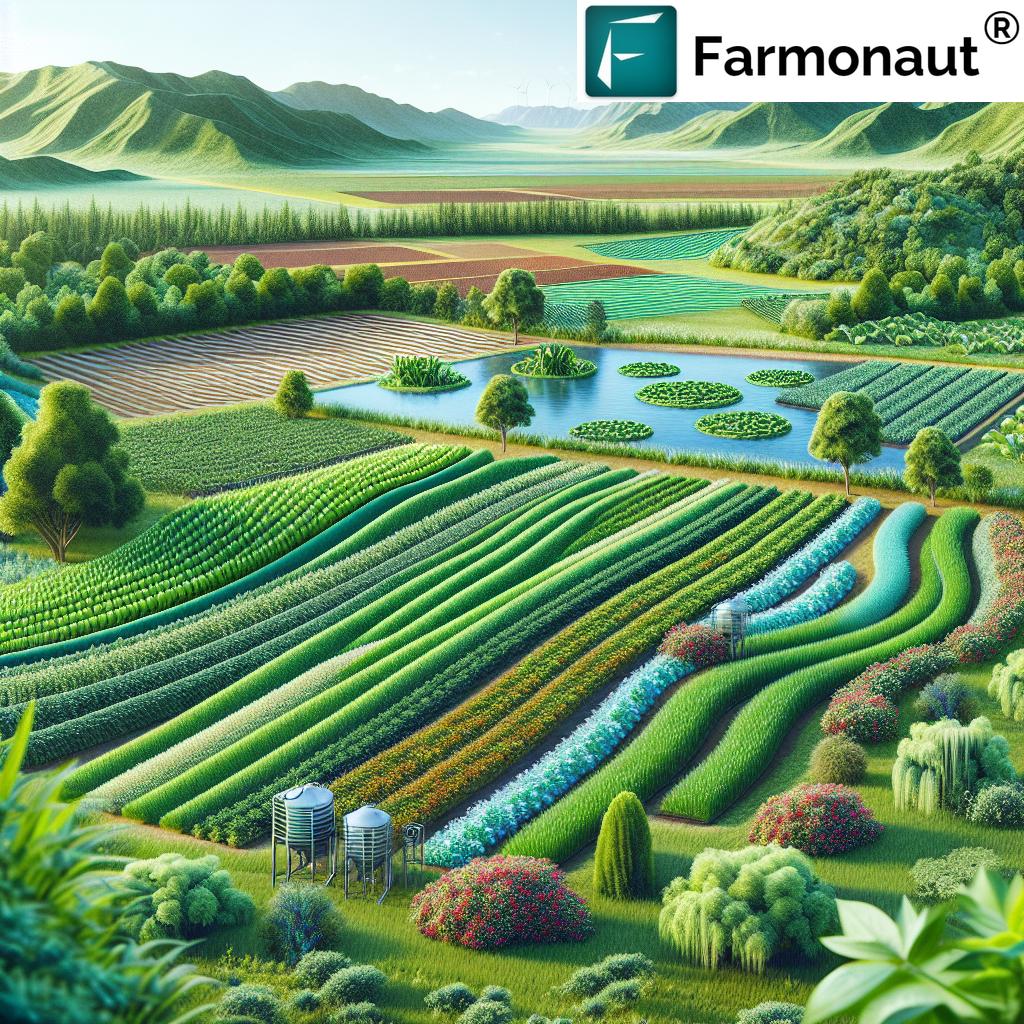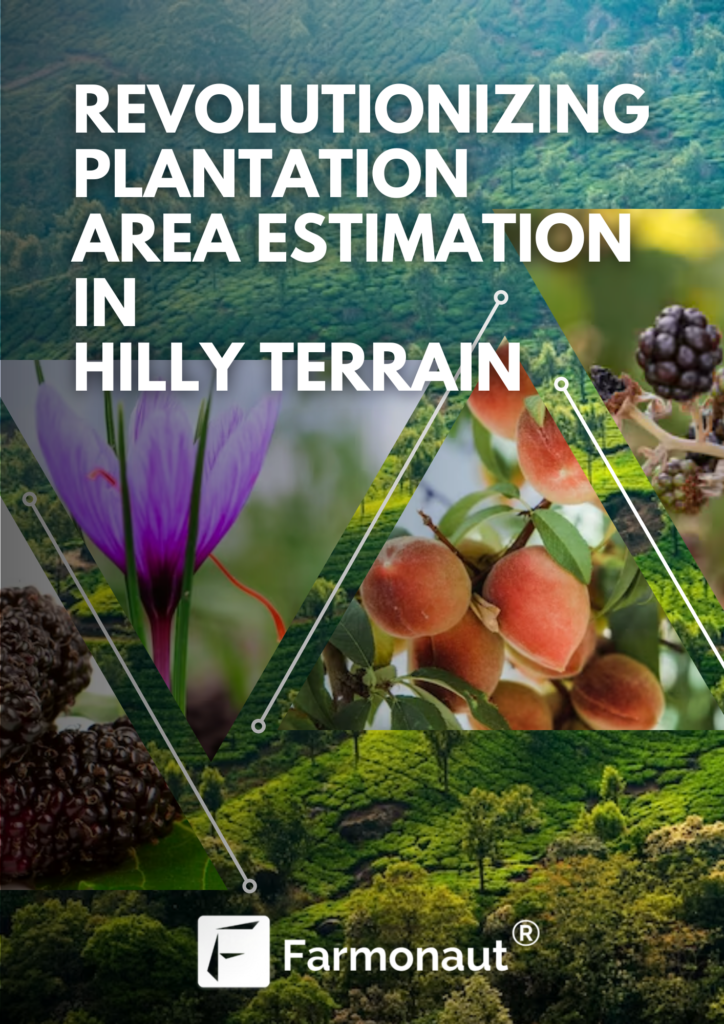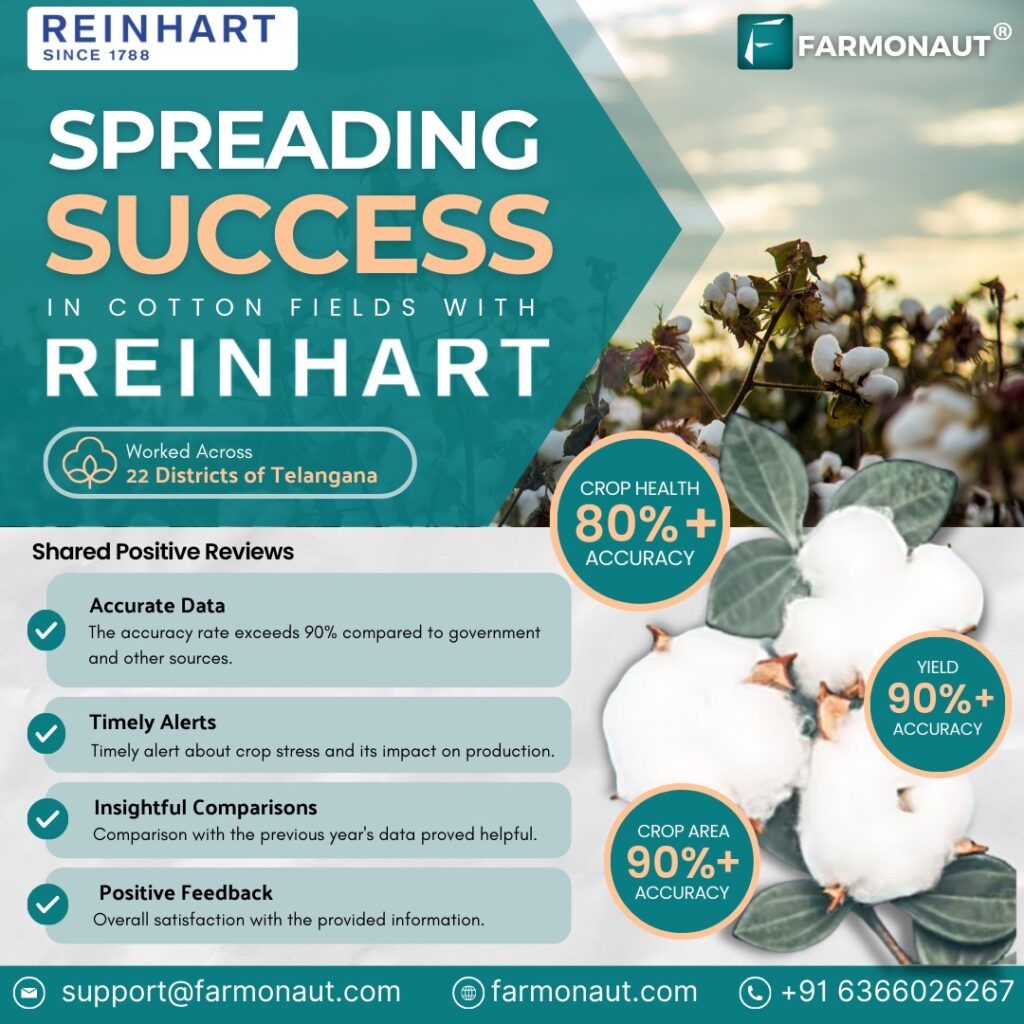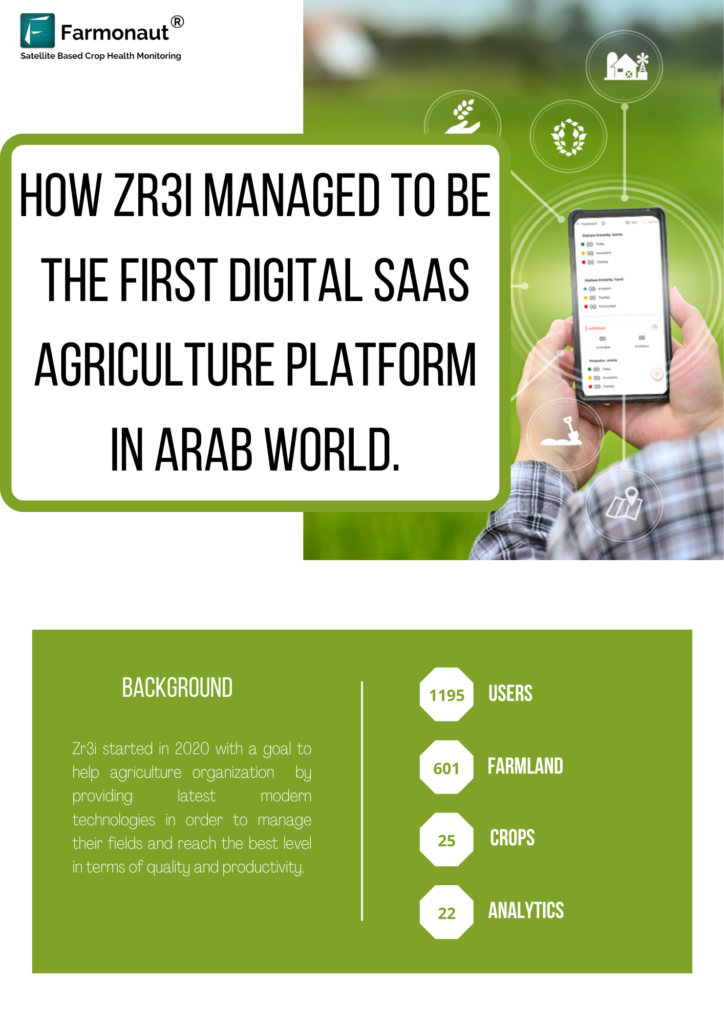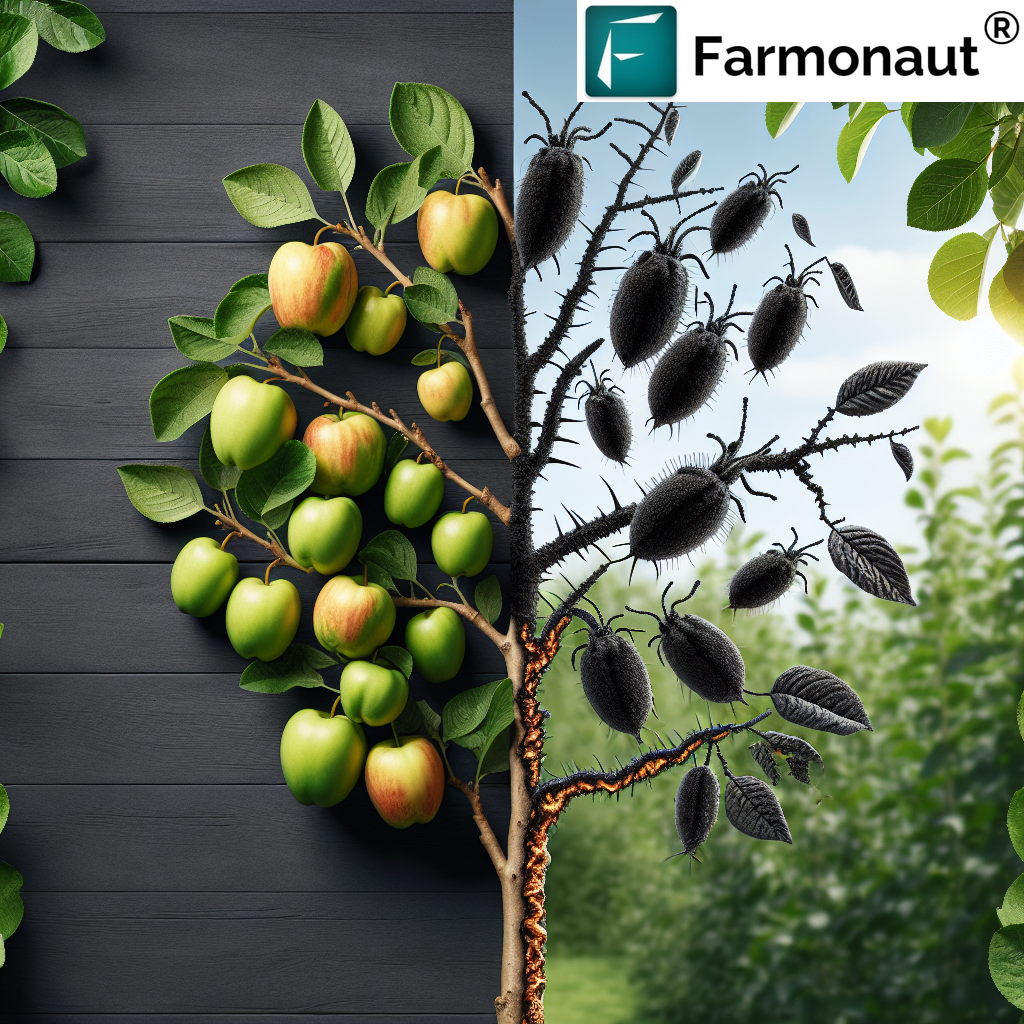Black Sigatoka: The Destructive Fungal Disease Threatening Banana Plants

In the world of banana cultivation, few threats loom as large as Black Sigatoka, a destructive fungal disease that has been wreaking havoc on banana plantations worldwide. At Farmonaut, we recognize the critical importance of understanding and managing this formidable adversary to ensure the sustainability of banana production. In this comprehensive guide, we’ll delve deep into the intricacies of Black Sigatoka, exploring its causes, symptoms, impact, and most importantly, the cutting-edge solutions available to combat this menace.
Understanding Black Sigatoka: A Formidable Foe
Black Sigatoka, scientifically known as Mycosphaerella fijiensis or its asexual stage Pseudocercospora fijiensis, is a fungal pathogen that has earned its reputation as one of the most devastating diseases affecting banana plants. Often referred to as Black Leaf Streak Disease or Sigatoka negra in Spanish-speaking regions, this disease has become a significant concern for banana growers worldwide.
The Origin and Spread of Black Sigatoka
The history of Black Sigatoka is a tale of rapid spread and adaptation. First identified in Fiji in 1963, the disease quickly made its way across banana-growing regions globally. Its ability to thrive in various climatic conditions has contributed to its widespread prevalence. Today, Black Sigatoka can be found in nearly all major banana-producing countries, posing a constant threat to both commercial plantations and small-scale farms.
The Lifecycle of Black Sigatoka: Understanding the Enemy
To effectively combat Black Sigatoka, it’s crucial to understand its lifecycle. This knowledge forms the foundation for developing targeted control strategies. Let’s break down the stages of this fungal invader:
- Spore Germination: The lifecycle begins when fungal spores land on banana leaves. Under favorable conditions of high humidity and temperature, these spores germinate.
- Leaf Penetration: The fungus penetrates the leaf tissue through stomata or by directly piercing the leaf surface.
- Colonization: Once inside, the fungus begins to colonize the leaf tissue, feeding on plant cells and disrupting normal leaf functions.
- Symptom Development: As the infection progresses, visible symptoms start to appear on the leaf surface.
- Spore Production: The infected areas of the leaf begin to produce new spores, which can be spread by wind or rain to infect other parts of the plant or neighboring plants.
- Survival in Plant Residues: The fungus can survive in infected plant residues, serving as a source of inoculum for future infections.
Recognizing the Signs: Symptoms of Black Sigatoka
Early detection is key in managing Black Sigatoka. Being able to identify the symptoms at various stages can make a significant difference in controlling the disease’s spread. Here are the progressive stages of symptom development:
- Stage 1: Small, light-yellow spots appear on the lower surface of the leaf.
- Stage 2: Spots elongate and turn brown, becoming visible on both leaf surfaces.
- Stage 3: Spots darken and expand, often surrounded by a yellow halo.
- Stage 4: Spots become black and begin to coalesce, forming larger necrotic areas.
- Stage 5: Large areas of the leaf turn black and dry out, severely impacting photosynthesis.
- Stage 6: In severe cases, entire leaves may die and hang from the plant.
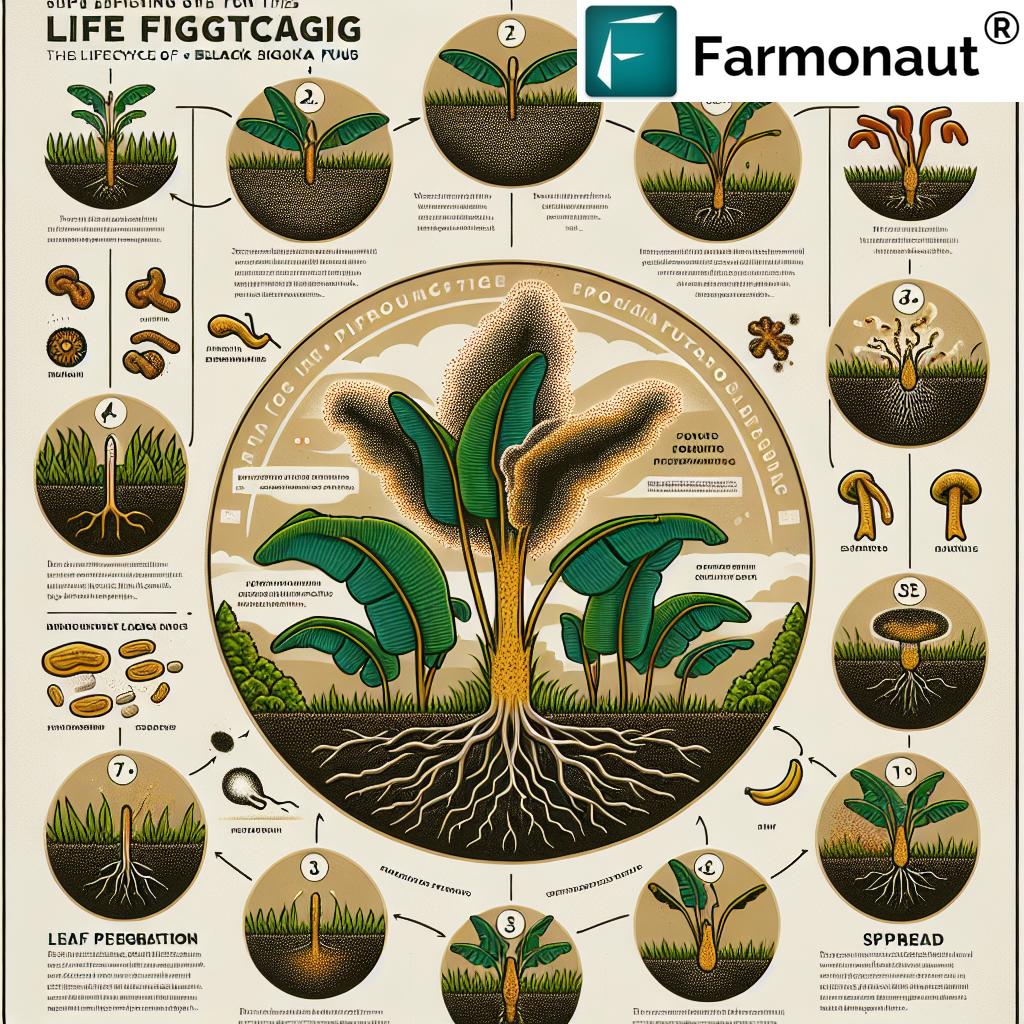
The Devastating Impact of Black Sigatoka
The impact of Black Sigatoka on banana production cannot be overstated. This disease affects various aspects of banana cultivation, leading to significant economic and agricultural consequences:
1. Reduced Yield and Quality
Black Sigatoka can cause substantial yield losses, ranging from 30% to 50% in severe cases. The disease affects fruit development, leading to premature ripening and reduced bunch weight. This not only decreases the overall yield but also impacts the quality of the harvested fruit.
2. Increased Production Costs
Managing Black Sigatoka often requires intensive fungicide applications, significantly increasing production costs. This financial burden can be particularly challenging for small-scale farmers with limited resources.
3. Environmental Concerns
The extensive use of fungicides to control Black Sigatoka raises environmental concerns. These chemicals can have detrimental effects on soil health, water quality, and local ecosystems.
4. Impact on Food Security
Bananas are a staple food in many tropical and subtropical regions. The reduced yield and increased cost of production due to Black Sigatoka can have serious implications for food security in these areas.
5. Trade Restrictions
The presence of Black Sigatoka can lead to trade restrictions, affecting the export potential of affected regions and impacting the global banana market.
Factors Influencing Black Sigatoka Development
Understanding the factors that contribute to the development and spread of Black Sigatoka is crucial for effective management. Several environmental and agricultural factors play a role:
1. Climate Conditions
Black Sigatoka thrives in warm, humid conditions. High humidity and temperatures between 25°C and 28°C (77°F to 82°F) are ideal for spore germination and disease development.
2. Rainfall Patterns
Rainfall plays a dual role in the disease cycle. It provides the necessary moisture for spore germination and also aids in the spread of spores through water splash.
3. Wind Patterns
Winds are crucial in the long-distance dispersal of Black Sigatoka spores. Strong winds can carry spores over great distances, facilitating the spread of the disease to new areas.
4. Banana Varieties
Different banana varieties exhibit varying levels of susceptibility to Black Sigatoka. Some cultivars are more resistant than others, influencing the severity and spread of the disease.
5. Crop Management Practices
Agricultural practices such as plant spacing, irrigation methods, and leaf pruning can influence the microclimate within banana plantations, affecting disease development.
Strategies for Controlling Black Sigatoka
Effectively managing Black Sigatoka requires a multi-faceted approach. At Farmonaut, we advocate for an integrated pest management strategy that combines various methods to control the disease while minimizing environmental impact. Here are some key strategies:
1. Cultural Control Methods
- Leaf Pruning: Regular removal of infected leaves can help reduce the inoculum load in the plantation.
- Proper Drainage: Improving drainage in plantations helps reduce humidity levels, creating less favorable conditions for fungal growth.
- Plant Spacing: Adequate spacing between plants improves air circulation, reducing humidity and disease pressure.
- Weed Control: Effective weed management can improve air circulation and reduce overall humidity in the plantation.
2. Chemical Control
While we at Farmonaut prioritize sustainable practices, chemical control remains a crucial component in managing severe Black Sigatoka infections:
- Fungicide Applications: Systematic application of fungicides can effectively control the disease. However, it’s crucial to rotate fungicides to prevent the development of resistance.
- Timing of Applications: Proper timing of fungicide applications based on disease forecasting models can improve efficacy while reducing overall chemical use.
3. Biological Control
Exploring biological control agents is an area of growing interest in sustainable Black Sigatoka management:
- Antagonistic Microorganisms: Certain bacteria and fungi have shown potential in suppressing Black Sigatoka development.
- Plant Extracts: Some natural plant extracts have demonstrated antifungal properties against the Black Sigatoka pathogen.
4. Resistant Varieties
Developing and utilizing banana varieties with increased resistance to Black Sigatoka is a long-term strategy for disease management:
- Breeding Programs: Ongoing research focuses on breeding banana varieties with improved resistance to Black Sigatoka.
- Genetic Engineering: Genetic modification techniques are being explored to develop banana plants with enhanced disease resistance.
5. Advanced Monitoring and Early Detection
At Farmonaut, we specialize in cutting-edge monitoring solutions that can revolutionize Black Sigatoka management:
- Satellite-Based Monitoring: Our advanced satellite imagery technology allows for early detection of disease symptoms across large areas. Learn more about our satellite monitoring services.
- AI-Powered Analysis: Our AI algorithms can analyze satellite data to identify potential disease hotspots before they become visible to the naked eye.
- Real-Time Alerts: Farmers receive timely alerts about potential disease outbreaks, enabling prompt and targeted interventions.
The Role of Technology in Black Sigatoka Management
In the fight against Black Sigatoka, technology plays an increasingly crucial role. At Farmonaut, we’re at the forefront of integrating advanced technological solutions into agricultural practices. Here’s how technology is transforming Black Sigatoka management:
1. Satellite-Based Crop Monitoring
Our satellite monitoring technology offers unprecedented capabilities in disease detection and management:
- Wide Coverage: Satellite imagery allows for monitoring vast areas of banana plantations simultaneously.
- Early Detection: Advanced spectral analysis can identify signs of stress in plants before visible symptoms appear.
- Temporal Analysis: Regular imaging enables tracking of disease progression over time.
2. Artificial Intelligence and Machine Learning
AI and machine learning algorithms enhance our ability to interpret complex data:
- Pattern Recognition: AI can identify patterns indicative of Black Sigatoka infection across large datasets.
- Predictive Modeling: Machine learning models can predict disease spread based on historical data and current conditions.
- Automated Alerts: Our system generates automated alerts when potential disease outbreaks are detected.
3. Mobile Applications
We’ve developed user-friendly mobile applications to put powerful tools in the hands of farmers:
- Real-Time Monitoring: Farmers can access up-to-date information about their plantations directly from their smartphones.
- Interactive Maps: Our apps provide interactive maps highlighting areas of concern within plantations.
- Decision Support: The apps offer recommendations for targeted interventions based on real-time data.
Download our mobile app for iOS here or for Android here.
4. Weather Forecasting Integration
Accurate weather forecasting is crucial in predicting disease risk:
- Microclimate Analysis: Our system integrates local weather data to provide accurate microclimate analysis for individual plantations.
- Disease Risk Forecasting: By combining weather data with disease models, we can forecast periods of high disease risk.
- Optimized Spray Scheduling: This integration allows for more efficient scheduling of fungicide applications.
5. Data Analytics and Reporting
Our advanced analytics provide valuable insights for long-term disease management:
- Trend Analysis: Historical data analysis helps identify long-term trends in disease prevalence and spread.
- Performance Metrics: Farmers can track the effectiveness of their disease management strategies over time.
- Customized Reports: We generate detailed reports tailored to the specific needs of each plantation.
Comparative Analysis: Traditional Monitoring vs. Farmonaut Satellite System
To illustrate the advantages of our advanced technology, let’s compare traditional monitoring methods with the Farmonaut Satellite System for Black Sigatoka detection:
| Feature | Traditional Monitoring | Farmonaut Satellite System |
|---|---|---|
| Early Detection | Limited to visible symptoms | Can detect stress before visible symptoms appear |
| Coverage Area | Limited by manual inspection capacity | Can cover vast areas simultaneously |
| Accuracy | Subjective, depends on inspector’s expertise | High accuracy through spectral analysis and AI |
| Cost-effectiveness | Labor-intensive and time-consuming | Highly cost-effective for large-scale monitoring |
| Real-time Monitoring | Periodic inspections only | Continuous monitoring with regular updates |
The Future of Black Sigatoka Management
As we look to the future, several emerging trends and technologies promise to further revolutionize Black Sigatoka management:
1. Precision Agriculture
The integration of GPS technology, drones, and IoT sensors will enable highly targeted disease management strategies, reducing the need for broad-spectrum fungicide applications.
2. Genetic Engineering and CRISPR Technology
Advances in genetic engineering, particularly CRISPR gene-editing technology, may lead to the development of banana varieties with enhanced resistance to Black Sigatoka.
3. Big Data and Predictive Analytics
The accumulation of vast amounts of data on disease patterns, climate conditions, and management practices will enable more accurate predictive models for disease outbreaks.
4. Nanotechnology
Nanoparticle-based fungicides and delivery systems may offer more effective and environmentally friendly methods of disease control.
5. Blockchain for Supply Chain Management
Blockchain technology could improve traceability in banana production, helping to manage disease spread and ensure the quality of disease-free planting material.
Farmonaut’s Commitment to Sustainable Banana Production
At Farmonaut, we’re committed to driving innovation in agricultural technology to support sustainable banana production. Our advanced satellite monitoring and AI-powered analytics are just the beginning. We’re continuously exploring new ways to integrate cutting-edge technologies into practical, user-friendly solutions for farmers and agricultural businesses.
By leveraging our satellite technology and data analytics, we aim to:
- Reduce the environmental impact of fungicide use through more targeted applications
- Improve the economic viability of banana farming by reducing losses to Black Sigatoka
- Enhance food security by supporting stable banana production
- Empower farmers with real-time information and decision-making tools
We invite you to explore our range of services and see how Farmonaut can transform your approach to managing Black Sigatoka and other agricultural challenges. Visit our website to learn more about our satellite monitoring services, or check out our API documentation for developers interested in integrating our technology into their own applications.
Conclusion: A United Front Against Black Sigatoka
Black Sigatoka remains a formidable challenge in banana cultivation, but with advances in technology and a comprehensive management approach, we’re better equipped than ever to combat this destructive disease. At Farmonaut, we believe that by combining traditional agricultural knowledge with cutting-edge technology, we can create a more resilient and sustainable banana industry.
The fight against Black Sigatoka is not just about protecting crops; it’s about ensuring food security, supporting livelihoods, and promoting sustainable agricultural practices. By staying informed, adopting innovative solutions, and working together, we can mitigate the impact of this disease and secure the future of banana production worldwide.
We encourage all stakeholders in the banana industry – from small-scale farmers to large plantations, researchers to policymakers – to embrace these technological advancements and work collaboratively towards effective Black Sigatoka management. Together, we can turn the tide against this persistent threat and pave the way for a more sustainable and prosperous future in banana cultivation.
FAQs About Black Sigatoka and Farmonaut’s Solutions
- Q: What makes Black Sigatoka so destructive to banana plants?
A: Black Sigatoka is highly destructive due to its rapid spread, ability to quickly colonize leaf tissue, and its impact on photosynthesis. It can significantly reduce yields and fruit quality, leading to substantial economic losses. - Q: How does Farmonaut’s satellite monitoring detect Black Sigatoka before visible symptoms appear?
A: Our satellite technology uses advanced spectral analysis to detect changes in plant health indicators, such as chlorophyll content and water stress, which can indicate early stages of infection before visible symptoms develop. - Q: Can Farmonaut’s technology be used for other banana diseases besides Black Sigatoka?
A: Yes, our satellite monitoring and AI analytics can be adapted to detect various plant stresses and diseases, not just Black Sigatoka. The technology is versatile and can be applied to multiple crop types and conditions. - Q: How often does Farmonaut update its satellite imagery for disease monitoring?
A: The frequency of updates can vary depending on the specific service package, but we typically provide updates every 3-5 days, ensuring timely detection of potential disease outbreaks. - Q: Is Farmonaut’s technology suitable for small-scale banana farmers?
A: Absolutely. We offer scalable solutions that can be tailored to farms of all sizes. Our mobile app makes the technology accessible even to small-scale farmers, providing valuable insights at an affordable cost. - Q: How does Farmonaut integrate weather data into its disease prediction models?
A: We incorporate local weather data and forecasts into our AI models, which analyze how weather conditions might influence disease development and spread, allowing for more accurate risk assessments. - Q: Can Farmonaut’s system help in reducing fungicide use?
A: Yes, by providing early detection and targeted information about disease risk, our system can help optimize fungicide applications, potentially reducing overall usage while maintaining effective disease control. - Q: How does Farmonaut ensure the accuracy of its disease detection?
A: We continually refine our AI models using machine learning techniques, incorporating feedback from ground-truthing and expert verification to ensure high accuracy in our disease detection algorithms. - Q: Is training required to use Farmonaut’s technology for Black Sigatoka management?
A: While our system is designed to be user-friendly, we do provide training and support to ensure users can fully leverage the technology. Our team is always available to assist with implementation and ongoing use. - Q: How can I access Farmonaut’s Black Sigatoka monitoring services?
A: You can start by visiting our website or downloading our mobile app. We offer various subscription plans tailored to different needs and farm sizes. For more information, please contact our sales team or explore our online resources.
For more information on our services and how we can help you manage Black Sigatoka and other agricultural challenges, please visit our website or contact our team. Together, we can work towards a more sustainable and productive future in banana cultivation.



